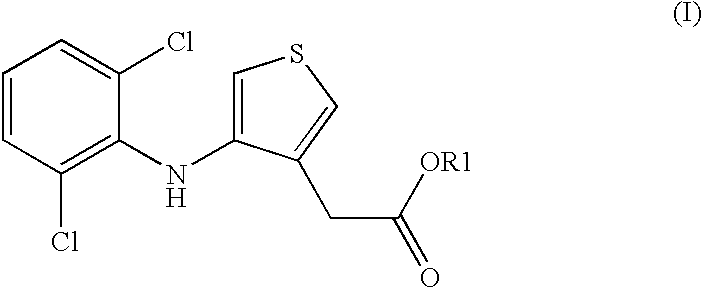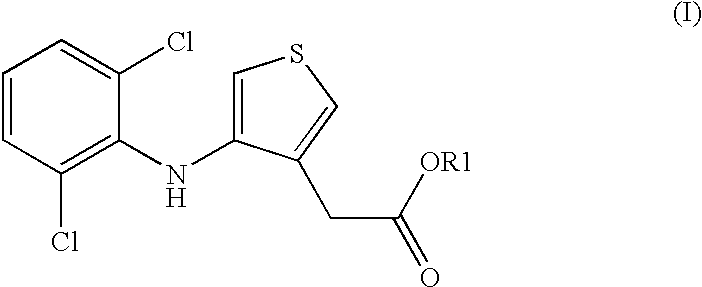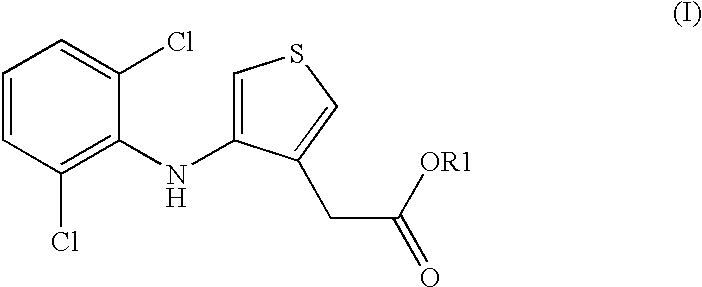Compositions comprising phenylaminothiophenacetic acid derivatives for the treatment of acute or adult respiratory distress syndrome (ARDS) and infant respiratory distress syndrome (IRDS)
a technology of phenylaminothiophenacetic acid and derivatives, which is applied in the direction of biocide, drug composition, aerosol delivery, etc., can solve the problems of small mortality reduction, risk of setting in motion a vicious circle, and damage to the lungs themselves
- Summary
- Abstract
- Description
- Claims
- Application Information
AI Technical Summary
Benefits of technology
Problems solved by technology
Method used
Image
Examples
example 1
[0024] 5.46 g of 1,2-dipalmitoyl-3-sn-phosphatidylcholine, 2.31 g of 1-palmitoyl-2-oleoyl-3-sn-phosphatidylgly-cerolammonium, 0.9 g of 4-(2,6-dichloroanilino)-3-thiopheneacetic acid, 0.38 g of palmitic acid, 0.21 g of calcium chloride and 0.15 g of rSP-C [recombinant lung surfactant protein SP-C (FF / I)] are dissolved in 500 ml of 2-propanol / water (90:10) and spray-dried in a laboratory spray drier Buchi B 191. Spray conditions: the gas for drying is nitrogen, the inlet temperature is 110.degree. C., the outlet temperature is 58-62.degree. C. This gives a fine white powder.
example 2
[0025] 5.46 g of 1,2-dipalmitoyl-3-sn-phosphatidyicholine, 2.31 g of 1-palmitoyl-2-oeoyl-3-sn-phosphatidylgly-cerolammonium, 0.09 g of 4-(2,6-dichloroanilino)-3-thiopheneacetic acid, 0.38 9 of palmitic acid, 0.21 g of calcium chloride and 0.15 g of rSP-C [recombinant lung surfactant protein SP-C (FF / I)] are dissolved in 500 ml of 2-propanol / water (90:10) and spray-dried in a laboratory spray drier Buchi B 191. Spray conditions: the gas for drying is nitrogen, the inlet temperature is 110.degree. C., the outlet temperature is 58-62.degree. C. This gives a fine white powder.
[0026] The invention also provides a method for treating mammals, including humans, suffering from IRDS or ARDS. The method comprises administering a therapeutically effective and pharmacologically tolerable amount of one of the compositions according to the invention to the diseased mammal.
[0027] The invention furthermore provides the compositions according to the invention for use in the treatment of IRDS and ARD...
PUM
| Property | Measurement | Unit |
|---|---|---|
| Length | aaaaa | aaaaa |
| Dimensionless property | aaaaa | aaaaa |
| Dimensionless property | aaaaa | aaaaa |
Abstract
Description
Claims
Application Information
 Login to View More
Login to View More - R&D
- Intellectual Property
- Life Sciences
- Materials
- Tech Scout
- Unparalleled Data Quality
- Higher Quality Content
- 60% Fewer Hallucinations
Browse by: Latest US Patents, China's latest patents, Technical Efficacy Thesaurus, Application Domain, Technology Topic, Popular Technical Reports.
© 2025 PatSnap. All rights reserved.Legal|Privacy policy|Modern Slavery Act Transparency Statement|Sitemap|About US| Contact US: help@patsnap.com



